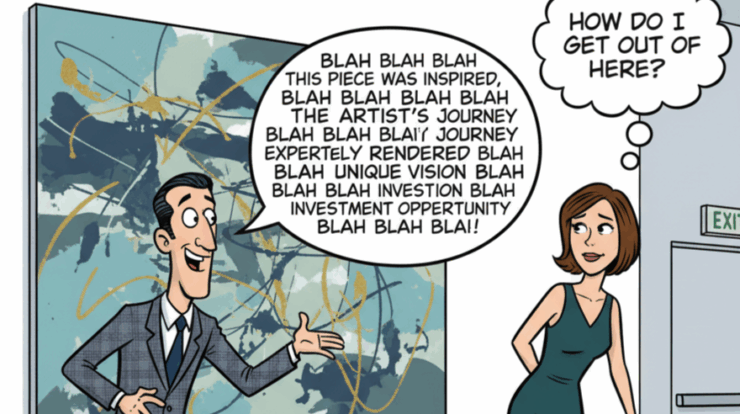
Most artists think selling means talking—describing the piece, explaining the process, filling the air with words that show confidence and professionalism. But in my 30+ years in art sales, I’ve learned that listening is far more powerful. The best conversations with collectors aren’t performances—they’re exchanges. Listening builds trust, reveals what matters to the buyer, and often turns a casual observer into a committed collector.
Conversations Beat Monologues
You can tell when someone is reciting a script. Their words might be polished, but there’s no exchange happening. The listener is politely waiting for their turn to leave.
Instead, think of each interaction about your art as a small, open-ended conversation. Ask the collector what drew them to the piece. Ask if they’ve collected before, or if they have a favorite subject. These questions aren’t just polite—they give you clues. The moment they start talking, you’re learning how to meet them where they are.
My 70/30 Rule
When I’m working with clients, my goal is for them to be talking about 70% of the time. That might sound backward for a salesperson, but it’s where real rapport happens. People enjoy talking about what interests them—and when they do, they reveal their motivations, tastes, and priorities.
To encourage this, I’ll often rephrase and reflect back what they’ve said:
“You mentioned you love the feeling of movement in this piece—tell me more about that.”
Repeating and summarizing isn’t just good manners; it shows you’re tuned in. It helps collectors clarify their own feelings about the art, and it signals that this isn’t a transaction—it’s a dialogue.
Tips for Better Listening and Conversation
Listening well is a skill like any other—it takes deliberate practice. Here are a few habits that can make a noticeable difference in how you connect with collectors:
-
Ask open-ended questions. Instead of “Do you like this piece?” try “What stands out to you about this one?”
-
Be genuinely curious. People can tell when your interest is real. Curiosity builds trust faster than polish.
-
Watch for nonverbal cues. Eye contact, posture, and tone tell you as much as words do.
-
Resist the urge to jump in. Give people space to think or expand on what they’re saying. Silence is productive.
-
Use what you hear. Reflect their words in your own language—connect what they value to what your art expresses.
-
End with a takeaway. Summarize what you’ve learned about their taste or interests—it reinforces that you were paying attention.
Listening Is a Form of Confidence
When you’re anxious, you fill silence with words. When you’re confident, you can let the silence breathe. You ask, you listen, and you trust that the work itself is carrying part of the conversation.
Good listening isn’t passive—it’s presence. And in art sales, presence builds trust faster than any clever line ever will.
